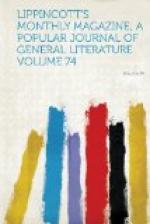The concentric labyrinth of the city’s plan is indeed something altogether unique; but whether it owes its origin to the fear of the old French barricade or to a desire for grandeur and scope, the effect attained is the same one of airy magnificence—monstrous avenues crossing the right angles of the streets in diagonals radiating from the White House and the Capitol, and all tiresomeness prevented by the accommodating way which these avenues have of turning out for any edifice that fancies their situation; while to keep upon them you are so perpetually crossing one street or losing your way down another that you may almost imagine yourself a spider walking across a web.
The designer of all this must have had a city in his mind’s eye that rivaled Napoleon’s Paris—buildings, monuments, marbles, fountains, trees, and everywhere great spaces and shining skies. For years, though, this visionary city has existed only among the castles of the air, and it is within a little while that the District government has begun to put in a substantial underpinning to the cloudy fabric. But although wretched thoroughfares and dilapidated dwellings, until the last decade, have characterized the place, the fine public buildings have for a long while awaited their fit surroundings—buildings mostly of the Grecian types, which, however unfit they might be for a land where damp dark heavens make all the spires that can spring up to catch the sunshine a necessity, are perfectly appropriate to a climate where the long hot summers demand the shelter of flat roofs and cool protecting porticoes. There are, then, already, the Patent Office, with its massive Doric simplicity; the Treasury, with the superb extent of its columned sides; the Post Office, with its dazzling Corinthian splendor; the Institution, with its romantic towers and turrets of dark red stone, ivy-grown and in the midst of gardens; and the Capitol, whose dome rises over the city, so pale, so perfect and so buoyant that it seems only a cloud among the clouds—a pile that by daylight looks like a white altar of liberty set on its hilltop among velvet lawns and embowering trees, and which by starlight—when you see the sentinel lamps throw out the great shadows of the arches at its foundation, see the lofty flights of steps with their exquisite gradation, see the long flying lines of the rows of columns, monoliths of marble, taking a sparkle of light and retreating into distance and darkness, and follow up the heights till your eye rests on the shadowy dome hanging in the mid-heavens with the stars themselves—seems in its vast white sublimity the shrine of nothing less than the Genius of the nation. And by and by, when the building shall be quite complete, and shrubbery shall have grown in the new grounds, when the almond and the tulip tree and that burning bush the scarlet Japan quince, shall have come to blossom there, and the giant magnolia shall lift its snowy urns of incense about the spot, imagination will be




